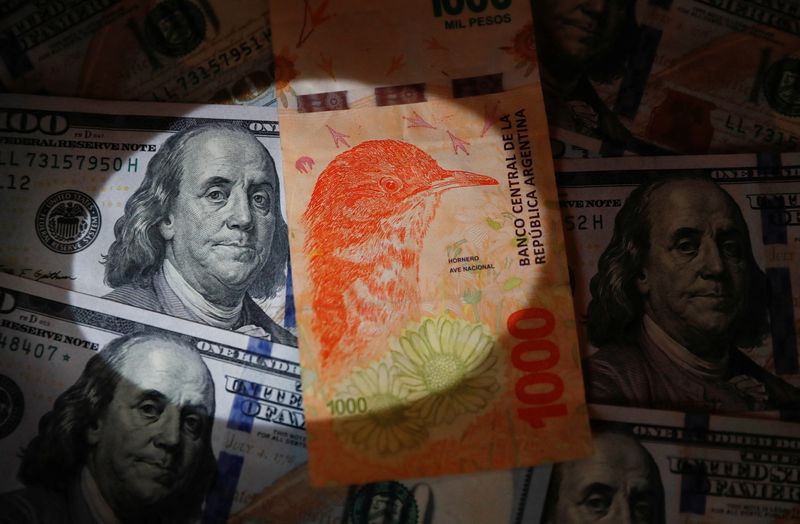By Jorge Otaola
BUENOS AIRES (Reuters) – Argentina’s 211% inflation rate and the return to a widening gap between official and parallel exchange rates is stoking expectations of another devaluation of the peso, just over a month after its dollar value was cut in half.
The South American country’s peso has been sliding since the turn of the year in the popular black market and other parallel markets, which for years have diverged sharply from the official rate, which is propped up by strict capital controls.
Dollars cost over 1,200 pesos in parallel markets, versus around 820 at the official exchange rate. That’s a gap of nearly 50%, which has doubled in recent weeks after narrowing sharply in December when the government devalued the peso more than 50%.
That widening is stirring market expectations that the government of libertarian Javier Milei may devalue again soon, especially with monthly inflation over 25% in December, well above the 2% monthly ‘crawling peg’ weakening the peso.
“If this rate of depreciation of the peso is sustained and there is no positive news on prices, expectations regarding a devaluation will increase,” said Pablo Besmedrisnik, director of the consulting firm Invenómica.
He added it would make more sense to devalue before the key harvest period in March-April of cash crops soy and corn, otherwise expectations of a devaluation then would encourage producers to postpone exports, hurting state coffers.
‘WAKE UP TO ANOTHER DEVALUATION’
Inflation at a three-decade high, demand for dollars by importers and political uncertainties this year have weighed on the peso, which had gained ground in parallel markets in the wake of the devaluation by Milei after he took office.
“I would not be surprised if one of these days we wake up to another significant devaluation by the central bank,” said a veteran local foreign exchange trader who asked not to be named, adding the 2% monthly crawling peg was “unsustainable”.
A devaluation, he said, would encourage more exports and help cut the fiscal deficit.
A central bank spokesperson declined to comment
Argentina has myriad parallel exchange rates, popular because access to the official market is strictly limited. The “CCL” rate has weakened 20% this year, the black market “blue” rate has lost 17%, while the official rate is down just 1.3%.
Argentina, which has a $44 billion program with the International Monetary Fund (IMF), has built up some $5 billion in foreign currency reserves this year, part of economic targets with the lender, helped by the weaker official peso.
Agustín Etchebarne, director at the Freedom and Progress Foundation, said that the government would likely devalue again in February-March ahead of the harvest. Argentina is the No. 3 corn exporter and one of the top processed soy suppliers.
“In my opinion, they have to get out of the exchange rate trap as soon as possible and have a true single and free exchange market, or well, dollarize,” he said, referring to a longer-term plan pitched by Milei to adopt the dollar.
“It’s clear that the 2% monthly devaluation with much higher inflation is not sustainable.”
(Reporting by Jorge Otaola; Editing by Adam Jourdan and Philippa Fletcher)
